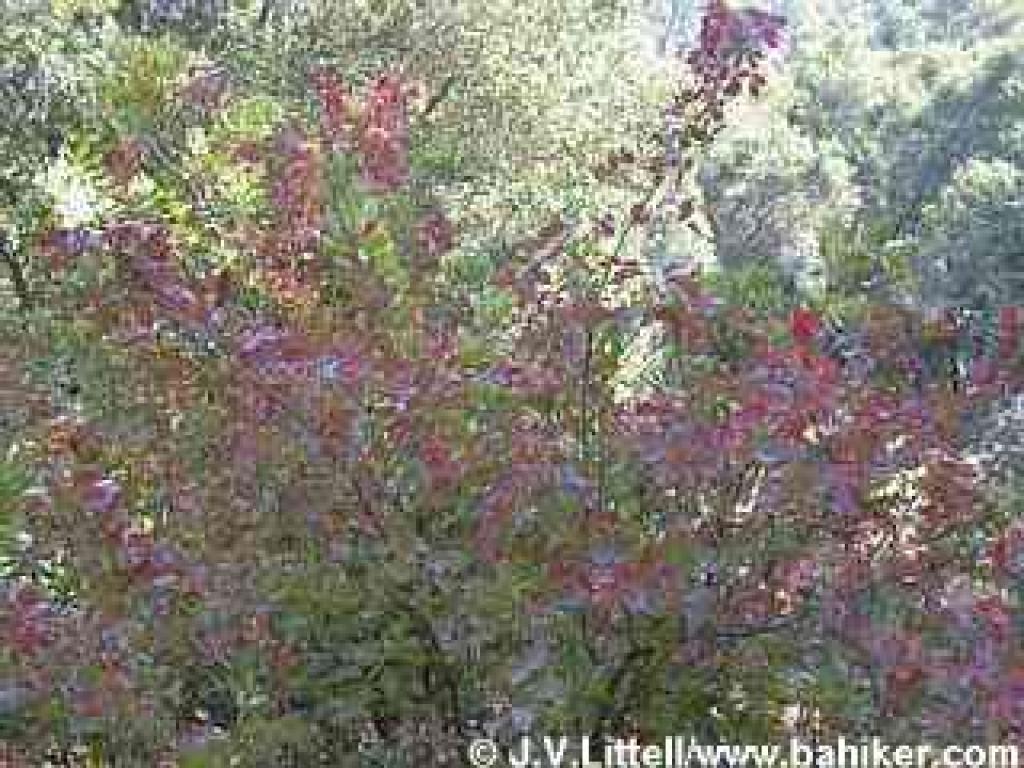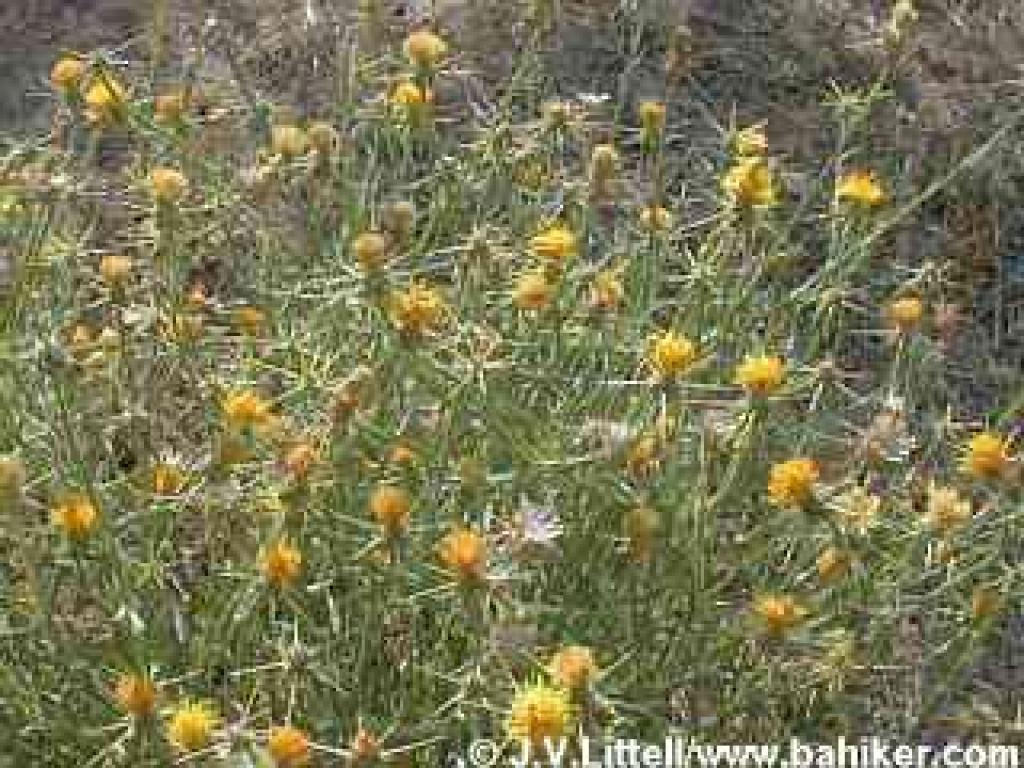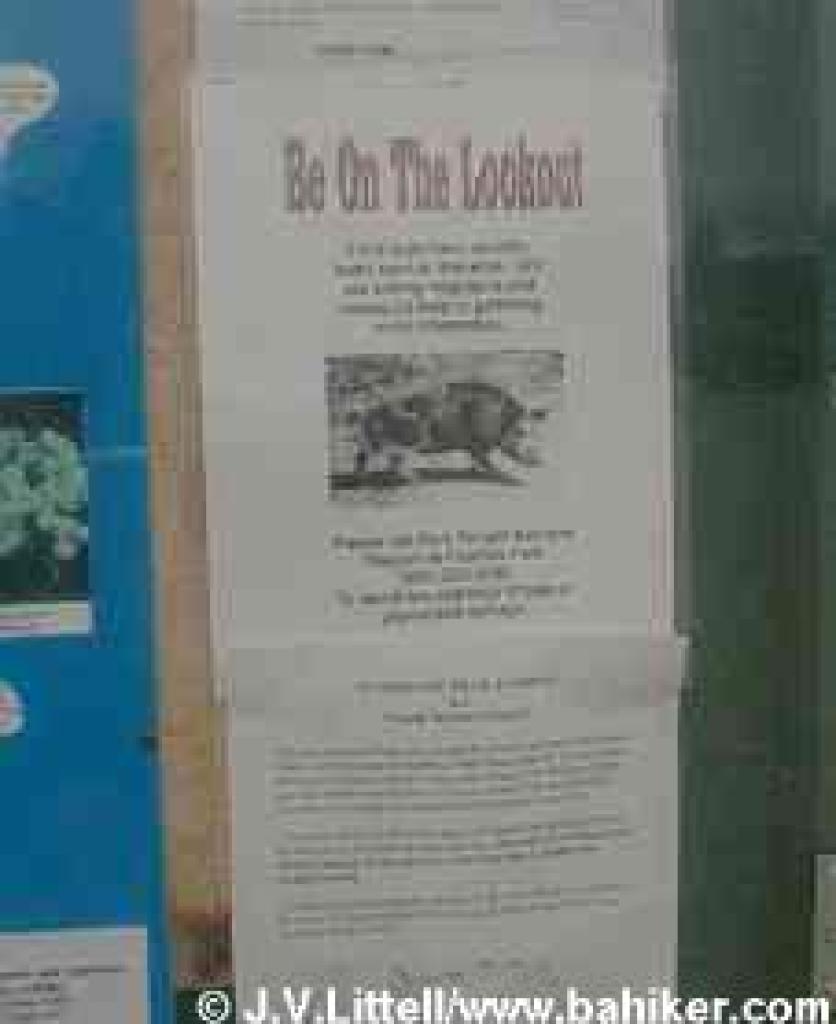By far, the plant that has the most potential negative
impact on your hiking experience is poison oak. Some people are particularly
sensitive to this plant,  while
others are hardly bothered. There are a lot of myths about poison oak,
and the best advice is just to stay away from it.
while
others are hardly bothered. There are a lot of myths about poison oak,
and the best advice is just to stay away from it.
I've had a few brushes with poison oak in the
last two years, and can report what it does to me. My first incident came when
I worked on a volunteer project building fences, and a large poison oak shrub
was unavoidable. I thought I was adequately protected by a long sleeved shirt,
long pants, and gloves, but I still broke out a week later. The rash started
on my hand, but the worst area was my stomach. At first the rash was a mass
of small red bumps. Then they became filled with clear fluid. After that the
affected areas resembled a third degree burn, with pink, raised flesh. I did
get some relief from Benadryl's Itch Stopping Gel. The episode lasted about
a week.
After each volunteer project the following year,
I had similar, but subsequently weaker breakouts. I finally realized that I
was being exposed to poison oak over and over again from my shirt. I wear a
particular shirt for volunteer projects (and I never wear it except for projects),
and the poison oak oil remained on the shirt, despite being washed after each
project. I've spoken with other people who claim that when one member of the
family has poison oak oil on his/her clothes, if those garments are washed with
the household laundry, other family members contract the rash. So either wash
your clothes separately, or perhaps get rid of the contaminated garments.
Some new products are on the market, including a soap that neutralizes the effect of the poison oak
oil. The trick is knowing you've made contact with the plant, then washing the
oil off quickly with cool water (hot water is thought to spread the oil). If
you stay on the trail while you hike, the chances of encountering poison oak
drop dramatically. Most people I know have made contact with poison oak off
the trails, either using the bushes as a bathroom, or bushwhacking through brush.
Even if you stay out of the bushes, it may be a good idea to bring a small bar
or tube of soap (Burt's Bees makes a poison ivy soap that works on poison oak)
with you, and remember to wash any exposed area of skin as soon as possible
after exposure. If you hike with a dog who likes to explore off the trail, keep
the dog off car seats and away from your skin until you can give the dog a good
wash -- canine to human contact is a common source of poison oak rash.
on the market, including a soap that neutralizes the effect of the poison oak
oil. The trick is knowing you've made contact with the plant, then washing the
oil off quickly with cool water (hot water is thought to spread the oil). If
you stay on the trail while you hike, the chances of encountering poison oak
drop dramatically. Most people I know have made contact with poison oak off
the trails, either using the bushes as a bathroom, or bushwhacking through brush.
Even if you stay out of the bushes, it may be a good idea to bring a small bar
or tube of soap (Burt's Bees makes a poison ivy soap that works on poison oak)
with you, and remember to wash any exposed area of skin as soon as possible
after exposure. If you hike with a dog who likes to explore off the trail, keep
the dog off car seats and away from your skin until you can give the dog a good
wash -- canine to human contact is a common source of poison oak rash.
For a bunch of photos of poison oak at different
times of year, visit the poison oak page (http://www.bahiker.com/plantpages/poak.html).
Yellow star thistle (centaurea solstitialis)
is an invasive, non-native plant now common in grassy areas around the bay area.
The sharp spines that radiate out from the stalk can cause discomfort when they
pierce the skin. People react differently to the plant; some report severe irritation
and itching. The plant is obvious year round, and is easy to avoid.
As far as animals go, it's been repeatedly said that
the most dangerous creature you're prone to encounter hiking in the bay area
is the tick. These tiny arachnids can carry Lyme Disease. Wearing long-sleeved
shirts and pants makes it more difficult for ticks to latch on to you, and if
your clothes are light colored it's easier to spot a tick. Typically, ticks
hang out in grassland, but they can be almost anywhere. Once a tick hops on
board a human it will usually head for a warm crease (armpits, behind the knee,
etc.), and then bite. If you find a tick in the process of biting you, use tweezers
to carefully pull the tick out. Try to get the entire tick out without squeezing
so hard that the tick body crushes. Once you get the tick out, you can have
the tick (and yourself) tested for disease. Contact your health professional
for details of where to bring the dead tick for testing. Otherwise, check yourself
for symptoms, which can start a few days after a bite. The most prominent symptom
is a bulls-eye rash. If unchecked, Lyme Disease can cause chronic fatigue, joint
pain, headache, and other more serious complications. For more info, visit the
Center for Disease Control's website (see links, below).
There are other problem arachnids to watch out
for across California, but the only dangerous spider you are likely to come
across in the bay area is the black widow. A bite from one can be fatal, and
a doctor should be located as soon as possible. Spiders, like snakes, generally
will not seek you out, but bite in self defense when disturbed. Stay away from
spider hangouts like woodpiles and unoccupied buildings. Tarantulas are known
in the bay area (they leave their nests to mate in late summer/early autumn),
and although they are frighteningly large, these spiders have a bite about as
dangerous as a bee sting.
Speaking of bee stings, yellow jackets are common
around San Francisco preserves. Rangers sometimes post signs near trailheads
when yellow jackets are nesting near trails. If you see one yellow jacket, chances
are there are more nearby, and you should leave the area.
The most feared creature in the bay area would probably
be the mountain lion (felis concolor). A shy, largely nocturnal creature
wary of humans, the mountain lion does not normally attack people, but fatal
encounters have occurred in California. These large cats eat mostly deer, and in most cases
will run from humans. The most prominent recent fatality, a jogger ambushed
by a mountain lion in the Sierra foothills, probably unintentionally provoked
the lion's hunting instinct. In the growing bay area, mountain lion habitat
is shrinking as humans invade their territory. Sightings are becoming more common,
but some people actually may be mistaking bobcats for mountain lions, so the
statistics could be misleading. If you do encounter a mountain lion, do not
run. Back slowly away from the animal, and make yourself look larger by raising
your arms above your head. If attacked, fight back. Do not bend down, as lions
usually aim for the neck in an attack.
have occurred in California. These large cats eat mostly deer, and in most cases
will run from humans. The most prominent recent fatality, a jogger ambushed
by a mountain lion in the Sierra foothills, probably unintentionally provoked
the lion's hunting instinct. In the growing bay area, mountain lion habitat
is shrinking as humans invade their territory. Sightings are becoming more common,
but some people actually may be mistaking bobcats for mountain lions, so the
statistics could be misleading. If you do encounter a mountain lion, do not
run. Back slowly away from the animal, and make yourself look larger by raising
your arms above your head. If attacked, fight back. Do not bend down, as lions
usually aim for the neck in an attack.
Coyotes (canis lantrans) have a bad reputation
for unwarranted attacks, although traditionally on domestic animals. Omnivores
by nature, coyotes are opportunist creatures who are known to take advantage
of weak and/or small pets and livestock. Increasingly in the bay area people
are reporting incidents with coyotes, especially while hiking with dogs. I've
seen several coyotes when hiking, and I've never felt any fear. But it's important
to remember that any wild animal can react in an unpredictable or menacing way.
Keep a safe distance from any wild animal and report any aggressive animal behavior
to the appropriate agency.
Wild, or feral pigs have drifted into the bay
area, particularly in the south, and are posing a threat to wildlife and plants.
Some of these animals are descendants of escaped livestock, while others are
derived from breeds introduced to some ill-founded hunting preserves in the
1800s. Pigs of this ilk have no real predators (except for the automobile),
and so populations can increase rapidly. Pigs love acorns, and it's possible
our oak tree forests will begin to shrink as the pigs eat the fallen acorns,
preventing new growth. They also damage root systems when they dig around trees.
Another problem is their aggressive disposition and fearsome size. Pigs do sometimes
charge humans, and have been even known to attack and kill small deer. They
range in size from about 75 pounds to over 400 pounds. Mount Tamalpais solved
their (previous) pig problem by installing miles of fencing (you can see some
of it along the Ridge Trail north of Fairfax-Bolinas Road) and with aggressive
hunting. In the south bay management agencies are trying to come up with a way
to manage this problem, but in the meantime be on guard for the pig invasion.
There have been reports in summer 2001 of aggressive,
non-rattling rattlesnakes. Several hikers have written to me describing encounters
with rattlers that did not rattle and were reluctant to leave the trail. Rattlesnakes
live throughout the bay area, but are most commonly spotted in dry, rocky, or
exposed zones during the warmest months of the year. The standard "rules"
for hiking in rattlesnake territory are:
1) do not put your hands (or feet) where you can't see them, i.e. the top of
a rock outcrop or in a log pile.
2) be extra cautious in hot weather, as snakes are more active.
3) scan the trail continuously as you hike.
4) keep children from running ahead on trails. Bites to children are more severe
than to adults.
5) Avoid tall grass where you can't see your feet (or a potential snake).
Should you encounter a rattler, once it is aware
of you, its body language will reveal its mood. A coiled rattler is primed for
a strike, while a stretched rattler is more sanguine (although snakes have been
reported to "lunge"). If the snake is within striking distance, you
should probably stand motionless and wait for the snake to calm down and move.
Small, slow steps backward are also an option. If you're out of immediate range,
you could either skirt the snake, or wait for the snake to move. Some people
believe tapping the ground with a stick (from a safe distance, rather than in
the snake's face) will encourage the snake to move on.
Do not injure or kill a rattlesnake. They are
an essential part of the bay area ecosystem. Also, educate yourself about rattlesnakes
and gopher snakes, which can be easily mistaken for each other.
If you happen to get bitten by a rattlesnake,
follow this protocol:
1) Try to stay calm (which seems impossible, but the toxin is spread through
your blood, and the faster your heart beats, the faster it is dispersed).
2) Take a few minutes and call for help. You could call the nearest ranger station
(this is another good reason to carry maps, as there are commonly phone numbers
on them), or a nearby hospital. Rattlesnake serum is not always available at
every hospital, and it's best to find a hospital with a confirmed supply. Rangers
can assist you in getting back to the trailhead, and can arrange emergency medical
transport.
3) If you don't have a phone, or if the phone doesn't work in your location,
assess the situation. If you're alone, you'll have to hike out by yourself.
If you've got company, either send the other person back to the trailhead and/or
emergency phone, or have the person help you walk back.
4) Forget the old stories of cutting the bite area and sucking the venom out.
There are snake bite extraction kits available at outdoor stores, but they are
perhaps best suited to remote attacks, where hiking back to the trailhead is
not practical. Unless you're deep in the backcountry, don't waste time trying
to get the venom out; put your energy into making your way to a hospital.
5) What to do if you are on a backpacking trip, more than 1 day from help and
out of cell phone range? Advise varies, but people have survived by simply staying
put and waiting the bite out. A healthy adult may be able to process the venom
out of his/her system. Keep the bit limb lower than the heart, remove restrictive
clothing and/or jewelry, and wash the bite area with soap and water. Hopefully
you would have a suction extractor, which should be used within 15 minutes.
Links:
GORP
info on poison oak http://www.gorp.com/gorp/health/oakivfaq.htm
Center
for Disease Control info on Lyme Disease http://www.cdc.gov/ncidod/dvbid/lyme/index.htm
California
Poison Control System Rattlesnake Page http://www.calpoison.org/public/rattler.html